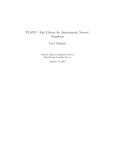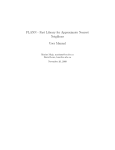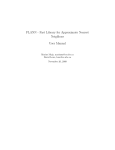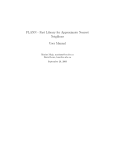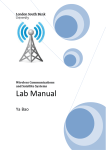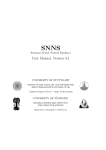Download NAG DMC User Guide - Numerical Algorithms Group
Transcript
User Guide
NAG DMC
NAG DMC
User Guide
1
Introduction
This document provides a guide to the functionality available in NAG DMC, and, for convenience
and clarity, is divided into sections based on a need to accomplish common tasks (as listed in Section
2). A brief summary of the contents of this document now follows.
Section 3.1 describes methods for data imputation, and Section 3.2 describes a method to find
outliers in continuous data values. Section 4 covers methods used to transform data values, and
Section 5 describes methods used for cluster analysis. Classification and regression models are
described in Section 6 and Section 7, respectively. Section 8 describes the method of association
rules, and, finally, Section 9 describes the utility functions available in NAG DMC.
2
Task Guide
This section provides some general guidance on the selection of suitable NAG DMC functions
to solve common analytical tasks. If there is a choice of functions for a particular task, further
guidance is given in the form of a table; otherwise the reader is directed to the relevant section in
this document which describes the methods and available functions.
The common analytical tasks are defined as:
(a)
(b)
(c)
(d)
(e)
(f)
(g)
(h)
replace missing values in data; see Section 3.1;
reduce the number of variables while retaining most of the information; see Section 4.2;
reduce the number of data records while retaining most of the information; see Section 5;
find unusual data records in a set of data; see Section 3.2;
find groups in data; see Section 5;
assign data records to one or more groups; see Section 6;
predict continuous values in data, e.g., a monetary cost; see Section 7;
compute rules for associations between data values; see Section 8.
3
Data Cleaning
3.1
Data Imputation
One approach to handling data containing values missing at random is to replace each missing value
by a suitable value. This task is known as data imputation, for which there are three fundamental
approaches.
The first approach, the simplest of the three, is to replace missing values on a continuous variable
by the mean of the variable and to replace missing values on a categorical variable by the mode of
the variable.
The second approach is to find the data record that is most similar to the one with the missing
value; this record is called the donor. If there are more than one possible donors then the donor
used can be selected in different ways, either by choosing one at random or by selecting the first
in the list. In these approaches the skill is in selecting the best variables to match the recipient
and the donor. An effective method used to select donors is to use a set of distance criteria for
a set of variables. For continuous variables, the choices of distance criteria include the Euclidean,
Manhattan, regression and threshold distances; for categorical variables simple (Boolean) matching
and scaled rank differences are common choices. The user may also supply distance tables for
categorical variables.
The third approach is to use mathematical models to predict the missing value. In general, an
iterative approach can be used to fit a model by using data containing missing values. Starting
User Guide.1
User Guide
NAG DMC
with guesses for the missing values, a model is fitted to the data and then used to produce better
estimates of the missing values. This procedure is then iterated until estimates of missing values
converge. If the fitting is by maximum likelihood and the prediction by taking the expected value
then the model is the EM algorithm for imputation.
3.1.1 Table
Method
Simple
Distance
EM
Most Intensive:
Memory Computation
?
?
Categorical Variable?
Yes
Yes
No
Table 1: Table of functions for data imputation tasks. If an analysis includes data on
categorical variables, the EM method for data imputation should not be used. See the
function documents described in Section 3.1.2 for further detail on these methods.
3.1.2 Functions
The function nagdmc impute simp replaces missing data values with either the mean or the mode
of variables for continuous and categorical variables, respectively.
The function nagdmc impute dist replaces missing data values by using a range of distance criteria
for variables.
The function nagdmc impute em replaces missing data values by using an EM algorithm.
Memory allocated by the data imputation functions may be returned to the operating system by
using nagdmc free impute.
3.2
Outlier Detection
Outlier detection concerns finding suspect data records in a set of data. Data records are identified
as suspect if they seem not to be drawn from an assumed distribution. In NAG DMC a multivariate
Normal distribution is assumed and, therefore, data values are assumed to be on continuous
variables.
The first step is to search for a subset of data records assumed to be “typical”. This search can
be based on either the Mahalanobis distance from the mean values or distances from medians of p
variables.
The method then grows the initial “typical” subset by including all data records at Mahalanobis
distances from the mean values less than the value of a corrected χ2 distribution with p degrees of
freedom, for a given rejection level, α.
When the size of the “typical” subset no longer changes, the data records not included in the
“typical” subset are deemed to be outliers.
If the Mahalanobis distance is selected to choose the initial “typical” subset, the EM data
imputation function (see Section 3.1) is used to impute any missing values in the data.
3.2.1 Functions
The function nagdmc bacon computes a feed-forward outlier search for a given a initial value for
the number of “good” data records and a rejection level for the χ2 distribution. The name BACON
is due to the acronym: Blocked Adaptive Computationally-efficient Outlier Nominator; and is
contrived in honour of Sir Francis Bacon who in 1620 wrote:
“Whoever knows the ways of Nature will more easily notice her deviations; and, on the other hand,
whoever knows her deviations will more accurately describe her ways.”
4
Data Transformations
4.1
Scaling Data
The contribution to a distance computation by data values on a continuous variable depends on
the range of its values. Thus, for functions which do not including scaling as an option, it is often
User Guide.2
NAG DMC
User Guide
preferable to transform all data values on continuous variables to be on the same scale. The usual
method of scaling continuous variables is to subtract the mean value from data values and divide
by the standard deviation. This results in data on continuous variables having zero mean and unit
variance.
4.2
Principal Component Analysis
Principal component analysis (PCA) is a tool for reducing the number of variables needed in an
analysis. PCA derives a set of orthogonal, i.e., uncorrelated, variables that contain most of the
information (measured in terms of variance or sums of squares) in the original data. The new
variables, called principal components, are calculated as linear transformations of the original data.
The choice of the number of principal components used can be based either on the number of
principal components needed to explain a given percentage of information in the data or by carrying
out statistical tests. There is also the question of what type of standardisation to use. If all the
variables are of a similar magnitude and variation, no standardisation is required. If the variables
differ in magnitude then standardisation should be applied. If the standard deviation is used then
this is equivalent to performing PCA on the correlation matrix.
4.3
Functions
4.3.1 Scaling
The function nagdmc scale scales data values on continuous variables to have zero mean and unit
variance.
4.3.2 Principal Components Analysis
The function nagdmc pca computes a principal component analysis. If standardisation is required
the options are: standardisation by standard deviation, and user-supplied scalings; otherwise the
options are sums of squares or variance. The function returns the coefficients that are used to
compute the new variables and information on the percentage of variation contained in each
component. The user has the option of supplying the means and, if required, the standard deviations
(if these are available) to avoid them being re-computed.
The function nagdmc pca score computes the transformed values of a data record, given a value
for the number of components to use and information returned by nagdmc pca.
5
Cluster Analysis
Cluster analysis is the statistical name for techniques that aim to find groups of similar data records
in a study. For example, if there are data on customers who purchased a number of product lines,
the retailer may wish to group together customers with similar purchasing patterns. Given these
groups, further analysis can be carried out, e.g., are there other key characteristics that define the
group?
Cluster analysis starts by working out how similar or how different two individuals are. Having
encoded and appropriately scaled data, the next step is to group together data records that are close
together. There are two main approaches, namely k -means clustering and hierarchical clustering.
5.1
k-means Clustering
In k-means clustering the user decides how many groups or clusters there are in the data. Unless
there is prior knowledge of the number of groups in the data, it is wise to experiment with different
values of k to determine which is best suited to their data. The method then allocates each data
record to one of k groups. The approach is to start with an initial allocation and then move data
records around between groups until the grouping with the smallest total within-group distance is
found.
The initial allocation can be found in a number of different ways. One approach is to select k
individuals at random and use then as the group centres. Then allocate the remainder to the
group with the nearest group centre. Other approaches to finding initial clusters include using
prior information to give the group centres or using key individuals as group centres.
User Guide.3
User Guide
NAG DMC
5.2
Hierarchical Clustering
Hierarchical clustering usually starts from the collection of data records and agglomerates them
step-by-step until there is only one group. The advantage of this approach is that by looking at
the way the groups join together there is an indication of how many groups there are in the data
and how well defined they are. There is also no requirement to provide a starting point. There are
six common methods for hierarchical clustering: single link, complete link, group average, centroid,
median and minimum variance. The difference between the methods is in the way distances between
groups are calculated from distances between individuals. This choice affects the properties of the
clustering method.
The standard approach to carrying out hierarchical clustering is first to compute the distance matrix
for all individuals then update this matrix as the analysis proceeds. This approach is suitable for at
most a few thousand individuals. However, of the six common methods of hierarchical clustering,
an alternative approach exists for two of them, namely the group average and minimum variance
methods. These two methods produce more “rounded” clusters than single link clustering. Both
of these two methods have the property that the group members can be replaced by the group
centroid or mean when calculating the between-group distances, so only the group means need to
be stored at any one time. This approach is efficient computationally since as many mergers as
possible are computed in parallel.
5.3
Table
Method
k-means Clustering
Hierarchical Clustering
Most Intensive:
Memory Computation
?
?
Number of Groups Known?
Yes
No
Table 2: Table of cluster analysis functions. You must give a value for the number
of groups in a data set for a k-means cluster analysis. See the function documents
described in Section 5.4 for further detail on these methods.
5.4
Functions
5.4.1 k-means Clustering
The utility function nagdmc rints can be used to randomly select data records used to form cluster
centres, whereas nagdmc nrgp can be used to allocate data records to the nearest cluster.
The function nagdmc kmeans computes a k-means cluster analysis for Euclidean distances.
Given a clustering, the function nagdmc wcss can be used for computing the within-cluster sums
of squares.
5.4.2 Hierarchical Clustering
The function nagdmc hclust provides either group average or minimum variance hierarchical cluster
analysis and returns the history of the agglomeration.
The function nagdmc cind takes the results of an hierarchical cluster analysis and allocates the
data records to the required number of groups.
6
Classification
6.1
Decision Trees
Decision trees use recursive partitioning to associate data records with a set of leaf nodes. Figure
1 shows an example of a simple binary decision tree. In the figure a test at root node A partitions
data into two child nodes: the internal node B; and the leaf node C. Node B partitions the data
associated with it into two leaf nodes, node D and node E. Since each parent node has two child
nodes, this tree is known as a binary tree. In general, decision trees in which parent nodes can be
associated with any number (greater than one) of child nodes are known as n-ary decision trees.
User Guide.4
User Guide
NAG DMC
A
B
D
C
E
Figure 1: Example of a binary decision tree. Ellipses are used to represent nodes in
the tree and parent nodes are linked by line segments to their child nodes in the tree.
A partition of data is found by evaluating the result of tests on data at a node and retaining the
best test according to a criterion. For the decision tree classifiers in NAG DMC this criterion is
either the Gini index of impurity or minimum entropy. Summary statistics, such as the mean or
mode of data, are used to label each leaf node with a value for the dependent variable in the data.
NAG DMC includes functions to compute binary and n-ary decision trees for classification.
6.2
Generalised Linear Models
Generalised linear models allow a wide range of models to be fitted. These included logistic and
probit regression models for binary data, and log-linear models for contingency tables. A generalised
linear model consists of:
(a) A distribution for the dependent variable, Y ;
(b) A model, known as a linear predictor, defined by a linear combination of independent
variables;
(c) A link function between the expected value of Y and the linear predictor.
In NAG DMC the following distributions are available:
(a) binomial distribution, typically used for binary classification tasks, the available link functions
are:
(i) logistic link;
(ii) probit link;
(iii) complementary log-log.
(b) Poisson distribution, typically used for count data, the available link functions are:
(i) exponent link;
(ii) identity link;
(iii) log link;
(iv) square root link;
(v) reciprocal link.
In each case maximum likelihood estimation estimates for the free parameters in a model are found
by using an iterative weighted least-squares procedure.
6.3
Multi-layer Perceptron Neural Networks
See Section 7.3 for an introduction to multi-layer perceptrons (MLP) models.
If a classification tasks has two classes, due to the nature of optimisation, one class should be coded
as zero and the other as one; otherwise for c > 2 classes c binary dependent variables should be
constructed that take the value one to indicate class membership and else are set to zero.
6.4
Nearest Neighbour Models
Given a data record x with an unknown value associated with its dependent variable, a k-nearest
neighbour model finds in a set of training data the k data records most similar to x. The measure of
similarity between x and training data records is a distance function computed over the independent
User Guide.5
User Guide
NAG DMC
variables. The value of the dependent variable is then set equal to the class value with the highest
probability amongst the k-nearest neighbours. Optionally, prior probabilities may be set for each
class value.
The measure of similarity used when comparing data records can be one of two distance functions.
Firstly, the Euclidean distance squared which calculates a measure of distance by evaluating the
sum of squared differences between data values. Secondly, the `1 -norm, or Manhattan distance,
which calculates a measure of distance by evaluating the sum of absolute differences between data
values.
6.5
Table
Method
Decision Trees
Generlised Linear Models
Multi-layer Perceptron
Nearest Neighbour Models
Most Intensive:
Memory Computation
?
?
More Than
Two Classes?
Yes
No
Yes
Yes
Unequal Class
Proportions?
Yes
Yes
No
Yes
Table 3: Table of functions used to classify data. MLP models should be applied to data
sets with (roughly) equal numbers of data records in each category. See the function
documents described in Section 6.6 for further detail on these methods.
6.6
Functions
6.6.1 Decision Trees
The function nagdmc gini tree computes a binary decision tree by using a criterion based on the
Gini index of impurity. The computed decision tree can be saved to and loaded from a binary file
by using the functions nagdmc save gini tree and nagdmc load gini tree, respectively. The memory
containing a Gini index decision tree can be returned to the operating system by using the function
nagdmc free gini tree.
The function nagdmc predict gini tree can be used to compute predictions for new data records
given a decision tree computed by nagdmc gini tree.
The function nagdmc entropy tree computes a n-ary decision tree by using the minimum entropy
criterion. The accuracy of an entropy decision tree on new data may be increased by pessimistic
error pruning of the fitted model. The function nagdmc prune entropy tree can be used for this
purpose.
The fitted entropy decision tree can be saved to and loaded from a binary file by using the functions
nagdmc save entropy tree and nagdmc load entropy tree, respectively.
The memory containing an entropy decision tree can be returned to the operating system by using
nagdmc free entropy tree.
The function nagdmc predict entropy tree can be used to compute predictions for new data records
given a decision tree computed by nagdmc entropy tree.
6.6.2 Generalised Linear Models
The function nagdmc binomial reg computes a generalised linear model with binomial errors.
The function nagdmc logit reg provides an easier to use interface for the computation of logistic
regression models, i.e., generalised linear models with binomial errors and the logistic link function.
The function nagdmc probit reg provides an easier to use interface for the computation of
generalised linear models with binomial errors and the probit link function.
The function nagdmc poisson reg computes a generalised linear model with Poisson errors.
The function nagdmc loglinear reg provides an easier to use interface for the computation of
generalised linear models with Poisson errors and the log-linear link function.
Information on fitted regression models is available by using nagdmc extr reg, and nagdmc predict reg
computes predictions for new data on independent variables.
User Guide.6
NAG DMC
User Guide
A fitted generalised linear model can be saved to disk by using nagdmc save reg and read into
memory by using nagdmc load reg. The function nagdmc free reg returns to the operating system
memory allocated to a generalised linear model.
6.6.3 Multi-layer Perceptron Neural Networks
The function nagdmc mlp is used to compute an MLP model. The function can be made to try
a number of initial conditions by using different random values for the free parameters in which
case the function uses the best of these initial optimisations as a starting point for the main
optimisation. The user controls the number of initial optimisations and the number of iterations of
the optimisation.
The function nagdmc predict mlp can be used to compute predictions for new data records given
MLP model information as returned by nagdmc mlp.
6.6.4 Nearest Neighbour Models
In NAG DMC, nearest neighbour approximations are found by using a two-stage process. Firstly,
a k -d tree is computed by using nagdmc kdtree. This tree can be saved into a binary file for future
use with nagdmc save kdtree, and loaded into memory from the file by nagdmc load kdtree. The
function nagdmc free kdtree returns the memory containing a k -d tree to the operating system.
Secondly, nearest neighbour approximations can be computed using prior probabilities of class
membership by nagdmc knnc.
7
Regression
7.1
Decision Trees
The two decision trees available in NAG DMC for regression tasks are both binary trees, see Section
6.1. Each decision tree uses as its criterion the minimum sum of squares about the mean for data
at a node. However, one of the decision trees uses a robust estimate of the mean of the dependent
variable at a node, whereas the other uses the simple average.
7.2
Linear Regression
Linear regression models can be used to predict an outcome y from a number of independent
variables. The predictive model is a linear combination of independent variables and a constant
term. The coefficients or weights in a model are estimated by using a training set of data with
known values of y and fitted using least squares approximation. The sign and magnitude of the
coefficients may be used interpret a fitted model. The ratio of a coefficient value to its standard
error measures its statistical importance; this ratio would generally be greater than two for the
variable to be considered worth keeping in a model.
Pre-processing of data values on categorical independent variables may be required. If a categorical
variables has more than two levels (for example, a variable could take the values red, blue or green),
dummy variables should be calculated and these used in a model; otherwise the two categories should
be encoded as zero and one.
7.3
Multi-layer Perceptron Neural Networks
Multi-layer perceptrons (MLPs) are flexible non-linear models that may be represented by a directed
graph, as shown in Figure 2.
User Guide.7
User Guide
NAG DMC
Input Layer
Hidden Layer
Output Layer
Figure 2: Diagram of a feed-forward MLP with a single hidden layer. Computational nodes in
the MLP are represented by circles; line segments connecting circles represent weights in the MLP.
The input layer consists of as many nodes as there are independent variables in the analysis. The
output layer consists of as many nodes as there are dependent variables in the analysis. You select
the number of nodes in the hidden layer, and, for a given number of independent and dependent
variables, this determines the number of free parameters in an MLP model.
A node in the input layer of an MLP takes the value of its independent variable and multiplies
this by a weight value. A node in either the hidden or output layer sums the contributions from
nodes it is connected to in the previous layer, and applies a transfer function to this sum. There are
several possibilities for transfer functions, including the sigmoidal (logistic) function, the hyperbolic
tangent function, and the linear function.
The process of optimising values of the free parameters in an MLP is known as training. Training
involves minimising the sum of squared error function between MLP predictions and training data
values. Typically, the error surface of such an optimisation is highly complex. Thus training an
MLP can be an intensive computational task and, therefore, MLPs are not generally suitable for
large data sets.
It is recommended that data values on continuous variables are scaled before running a multi-layer
perceptron as this makes MLPs easier to train successfully and tends to produce results with a
higher accuracy.
Even if it were possible to find a global minimum when optimising parameter values in a multi-layer
perceptron, it is unlikely that this would be desirable due to the problem of over-fitting a model.
In order to avoid over-fitting, the optimisation is usually halted prematurely by use of a set of
validation data. Hence the initial values for the free parameters in the MLP can have a significant
influence on the accuracy of approximation results. For this reason several optimisations should be
tried each with different initial conditions.
7.4
Nearest Neighbour Models
Given a data record x with an unknown value associated with its dependent variable, a k-nearest
neighbour model finds in a set of training data the k data records most similar to x. The measure of
similarity between x and training data records is a distance function computed over the independent
variables in x. The value of the dependent variable is then set equal to the mean value of the
dependent variable for the k-nearest neighbours.
The measure of similarity used when comparing data records can be one of two distance functions.
Firstly, the Euclidean distance squared which calculates a measure of distance by evaluating the
sum of squared differences between data values. Secondly, the `1 -norm, or Manhattan distance,
which calculates a measure of distance by evaluating the sum of absolute differences between data
values.
7.5
Radial Basis Function Models
A radial basis function (RBF) computes a scalar function of the distance from its centre location
to the values of independent variables in a data record, where distance is measured using the
Euclidean norm. The common choices of RBF include the linear, cubic, thin plate spline, Gaussian,
User Guide.8
User Guide
NAG DMC
multiquadric, inverse multiquadric and Cauchy functions. Centre locations of RBFs may be chosen
based on domain knowledge of the task or by cluster analysis, see Section 5.
An RBF model is a linear combination of the outputs of RBFs, the weights in which are given by
a least squares fit of the model to training data records.
As the computation of an RBF model involves distance calculations, any categorical variables with
more than two levels should be replaced by dummy variables in the analysis; values on categorical
variables with two levels should be labelled zero and one.
7.6
Table
Method
Regression Decision Tree
Linear Regression
Multi-layer Perceptron
Nearest Neighbour Models
Radial Basis Function Model
Most Intensive:
Memory Computation
?
?
Non-linear Task?
Yes
No
Yes
Yes
Yes
Table 4: Table of functions for regression tasks. Linear regression models may not give
accurate predictions for non-linear tasks (i.e., for tasks which cannot be adequately
described by a straight line). See the function documents described in Section 7.7 for
further detail on these methods.
7.7
Functions
7.7.1 Decision Trees
The function nagdmc reg tree computes binary decision trees using a criterion that partitions data
at a node so that the sum of squares about the mean is minimised. A computed decision tree can
be saved to a binary file by using nagdmc save reg tree and subsequently loaded into memory by
nagdmc load reg tree. The function nagdmc free reg tree returns to the operating system memory
used to store a decision tree computed by nagdmc reg tree.
The function nagdmc predict reg tree can be used to compute predictions for new data records
given a decision tree computed by nagdmc reg tree.
The function nagdmc waid computes binary decision trees using a criterion that partitions data at
a node so that the sum of squares about a robust estimate of the mean is minimised. A computed
decision tree can be saved to a binary file by using nagdmc save waid and subsequently loaded into
memory by nagdmc load waid. The function nagdmc free waid returns to the operating system
memory used to store a decision tree computed by nagdmc waid.
The function nagdmc predict waid can be used to compute predictions for new data records given
a decision tree computed by nagdmc waid.
7.7.2 Linear Regression
The function nagdmc linear reg computes the coefficients and returns information on the fit of the
model, e.g., the R2 value that gives the amount of variation in the dependent variable explained by
a fitted model.
The function nagdmc stepwise reg can be used as a automatic tool for model selection, i.e., by
selecting a combination of independent variables from a given set for inclusion in a linear regression
model.
Results from a fitted linear regression model can be extracted by using nagdmc extr reg, and
nagdmc predict reg computes predictions for new data on independent variables.
A fitted regression model can be saved to disk by using nagdmc save reg and read into memory
by using nagdmc load reg. The function nagdmc free reg returns to the operating system memory
allocated to a regression model.
7.7.3 Multi-layer Perceptron Neural Networks
The function nagdmc mlp is used to compute an MLP model. The function can be made to try
a number of initial conditions by using different random values for the free parameters in which
User Guide.9
User Guide
NAG DMC
case the function uses the best of these initial optimisations as a starting point for the main
optimisation. The user controls the number of initial optimisations and the number of iterations of
the optimisation.
The function nagdmc predict mlp can be used to compute predictions for new data records given
MLP model information as returned by nagdmc mlp.
7.7.4 Nearest Neighbour Models
In NAG DMC, nearest neighbour approximations are found by using a two-stage process. Firstly,
a k -d tree is computed by using nagdmc kdtree. This tree can be saved into a binary file for future
use with nagdmc save kdtree, and loaded into memory from the file by nagdmc load kdtree. The
function nagdmc free kdtree returns the memory containing a k -d tree to the operating system.
Secondly, nearest neighbour approximations can be computed by using nagdmc knnp.
7.7.5 Radial Basis Function Models
The function nagdmc rbf computes a least squares fit of a given number of RBFs of a chosen type
to training data records.
The function nagdmc predict rbf computes RBF model predictions given a fitted model for new
data records.
8
Association Rules
The goal of association analysis is to determine relationships between nominal data values. The
relationships take the form of rules and are expressed as:
Antecedent → Consequent.
For example, consider the rule:
{1, 41, 6} → 19,
which, in the case of market basket analysis, could be interpreted as:
“Customers who purchase the items with identifiers 1, 41 and 6 are likely to buy item 19.”
In general, for large data sets the number of available rules can be very high. For example, given
a supermarket product range of several thousand items there may be billions of rules. However,
the number of rules generated can be reduced by limiting the search to those rules with a high
probability.
Data for the association rules generator in NAG DMC must be sorted in ascending order for each
transaction.
8.1
Functions
The utility functions can be used to sort transaction data (see Section 8).
Once sorted, transaction data can be read into an array by using nagdmc assoc data. The function
nagdmc assoc computes association rules for the sorted data. Association rules can be printed by
using nagdmc assoc print.
9
Utility Functions
The utility functions are designed to support the main functions described above, and to help with
prototyping.
Utility functions are included which:
(a) compute random real and integer numbers with or without replacement. These functions can
be used, e.g., to compute random subsets of data records;
(b) rank and sort arrays of real and integer numbers;
(c) compute summary statistics, e.g., mean and variance for continuous variables, for a set of
data records;
(d) cross-tabulate results following a classification.
User Guide.10
NAG DMC
9.1
User Guide
Functions
nagdmc rng is the basic random number generator, returning a random number between 0 and 1
and using a starting point set by nagdmc srs, optionally using the system clock.
The function nagdmc rints uses the basic random number generator to produce a sample of random
integers in a given range that can be used to select data records from data set. The sample may
either include repeated numbers or exclude repeats.
Functions used to rank real and integer data are nagdmc rank real and nagdmc rank long,
respectively. The function nagdmc index converts a rank order into an index order.
Given a rank or index order, the functions used to reorder real-valued data and integer-valued data
are nagdmc order real and nagdmc order long, respectively.
nagdmc dsu updates means and sums of squares about the mean for a set of data. It can be used
to compute the sample mean and variance by processing chunks of data at a time.
The function nagdmc tab2 is a simple two-way tabulation that can be used to compare two-way
classifications.
User Guide.11












